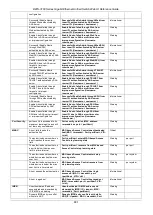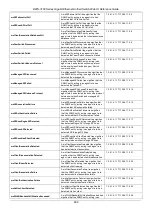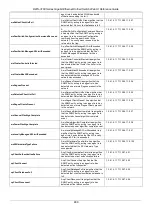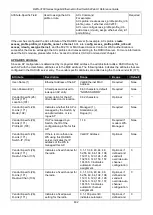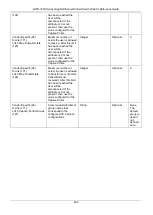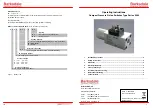
DWS-3160 Series Gigabit Ethernet Unified Switch Web UI Reference Guide
487
itself and that its configuration may have been
altered.
warmStart
A warmStart trap signifies that the SNMPv2
entity, acting in an agent role, is reinitializing
itself such that its configuration is unaltered.
1.3.6.1.6.3.1.1.5.2
linkDown
A linkDown trap signifies that the SNMP
entity, acting in an agent role, has detected
that the ifOperStatus object for one of its
communication links is about to enter the
down state from some other state (but not
from the notPresent state). This other state is
indicated by the included value of
ifOperStatus.
1.3.6.1.6.3.1.1.5.3
linkUp
A linkUp trap signifies that the SNMP entity,
acting in an agent role, has detected that the
ifOperStatus object for one of its
communication links left the down state and
transitioned into some other state (but not into
the notPresent state). This other state is
indicated by the included value of
ifOperStatus.
1.3.6.1.6.3.1.1.5.4
authenticationFailure
An authenticationFailure trap signifies that the
SNMP entity has received a protocol message
that is not properly authenticated. While all
implementations of SNMP entities MAY be
capable of generating this trap, the
snmpEnableAuthenTraps object indicates
whether this trap will be generated.
1.3.6.1.6.3.1.1.5.5
risingAlarm
This trap is an SNMP notification that is
generated when a high capacity alarm entry
crosses its rising threshold and generates an
event that is configured for sending SNMP
traps.
1.3.6.1.2.1.16.29.2.0.1
fallingAlarm
This trap is an SNMP notification that is
generated when a high capacity alarm entry
crosses its falling threshold and generates an
event that is configured for sending SNMP
traps.
1.3.6.1.2.1.16.29.2.0.2
newRoot
The newRoot trap indicates that the sending
agent has become the new root of the
Spanning Tree; the trap is sent by a bridge
soon after its election as the new root, e.g.,
upon action of the Topology Change Timer
immediately subsequent to its election.
Implementation of this trap is optional.
1.3.6.1.2.1.17.0.1
topologyChange
A topologyChange trap is sent by a bridge
when any of its configured ports transitions
from the Learning state to the Forwarding
state, or from the Forwarding state to the
Blocking state. The trap is not sent if a
newRoot trap is sent for the same transition.
Implementation of this trap is optional.
1.3.6.1.2.1.17.0.2
wsModeEnabled
A wsModeEnabled trap signifies that the
SNMP entity, acting in an agent role, has
detected that Wireless functionality on the
device is enabled.
1.3.6.1.4.1.171.12.96.11.0.1
wsModeDisabled
A wsModeDisabled trap signifies that the
SNMP entity, acting in an agent role, has
detected that Wireless functionality on the
device is disabled.
1.3.6.1.4.1.171.12.96.11.0.2
wsManagedAPDatabaseFull
A wsAPDatabaseFull trap signifies that the
SNMP entity, acting in an agent role, has
detected that AP Database is full.
1.3.6.1.4.1.171.12.96.11.0.3
wsManagedAPNeighborAPListFull
A wsManagedAPNeighborListFull trap
signifies that the SNMP entity, acting in an
agent role, has detected that ManagedAP
neighbor AP list is full.
1.3.6.1.4.1.171.12.96.11.0.4
wsManagedAPNeighborClientListFull
A wsManagedAPNeighborClientListFull trap
signifies that the SNMP entity, acting in an
agent role, has detected that ManagedAP
neighbor client list is full.
1.3.6.1.4.1.171.12.96.11.0.5









